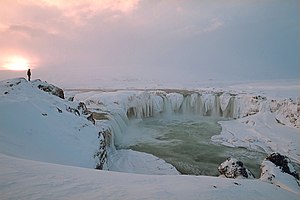Goðafoss

The Goðafoss (Icelandic: waterfall of the gods or waterfall of the goði) is one of the most spectacular waterfalls in Iceland. It is located in the Bárðardalur district of North-Central Iceland at the beginning of the Sprengisandur highland road. The water of the river Skjálfandafljót falls from a height of 12 meters over a width of 30 meters.[1]Goðafoss is in the glacial river Skjálfandafljót. The river has its origin deep in the Icelandic highland and runs from the highland through the Bárðardalur valley, all the way from Sprengisandur in the Highlands. The rock formation in and around the waterfall make it one of the greatest natural wonders in Iceland.[2] In the year 999 or 1000 the Lawspeaker Þorgeir Ljósvetningagoði made Christianity the official religion of Iceland. After his conversion it is said that upon returning from the Alþingi, Þorgeir threw his statues of the Norse gods into the waterfall. Þorgeir's story is preserved in Ari Þorgilsson's Íslendingabók. A window in the Cathedral of Akureyri (Akureyrarkirkja) illustrates this story. MS Goðafoss, an Icelandic ship named after the waterfall, was carrying both freight and passengers. It was sunk by a German U-Boat in World War II, resulting in great loss of lives.




See also
-
Fosshóll restaurant at the turnoff to Goðafoss
-
Ring Road bridge over Skjálfandafljót river
-
Goðafoss
-
Panorama
-
Canoe in Goðafoss
References
- ^ Andrew Evans (2011). Iceland. Bradt Travel Guides. ISBN 184162361X, 9781841623610. Page 365.
- ^ "Hit Iceland information page about Iceland"





